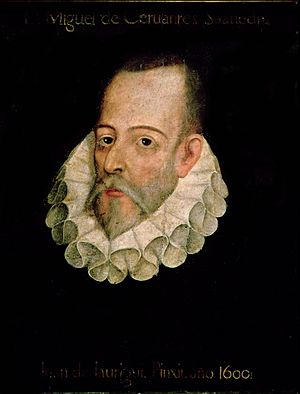Juan de Jáuregui facts for kids
Juan Martínez de Jáuregui y Aguilar (born November 24, 1583 – died January 11, 1641) was a Spanish poet, scholar, and painter. He lived during Spain's "Siglo de Oro" (Golden Age), a time when art and literature were very important. He was known for his beautiful poems and his skills as an artist.
Early Life of Juan Jáuregui
Juan Martínez de Jáuregui was born and baptized in Seville, Andalusia, Spain. His father, Miguel Martínez de Jáuregui, was a hidalgo. A hidalgo was a Spanish nobleman who did not have a special title like a duke or count. His mother was Doña Isabel de la Sal. Juan was the fifth of their ten children. He later changed his mother's last name in his own name to "Aguilar," which came from one of his grandmothers.
Not much is known about his early years. However, in one of his writings about painting, he mentioned traveling to Italy. It is believed he stayed in Rome to study painting there.
Juan Jáuregui's Career
Juan Jáuregui returned to Spain around 1610. By then, he was known as both a talented painter and a poet. The famous writer Miguel de Cervantes, who wrote Don Quixote, mentioned Jáuregui. Cervantes said that Jáuregui painted his portrait, but sadly, this painting is now lost. Cervantes also praised Jáuregui's translation of a poem called Aminta.
In 1618, Jáuregui published a collection of his own poems called Rimas. This book also included his translations of works by ancient poets like Horace. The book's introduction caused some debate because Jáuregui openly spoke against a complex writing style called culteranismo. This style was popular at the time, especially with another Spanish poet named Luis de Góngora.
Later, Jáuregui became a groom of the chamber for King Philip IV of Spain. This was an important position in the royal court. In 1624, he wrote a detailed explanation of his artistic ideas in a work called Discurso poético. This book was a clever attack on the new, complex writing styles. Because of his work, he was made a member of the honorable Order of Calatrava. However, his own poem Orfeo, also published in 1624, showed that he was starting to be influenced by the very style he had criticized.
Death
Juan Jáuregui died in Madrid on January 11, 1641. After his death, a translation he made of a long poem called Pharsalia was published in 1684. This translation showed that Jáuregui had fully adopted the new, complex style of writing. Some people believe he deliberately made the ancient poem sound like Góngora's work. Others think he simply followed the popular taste of his time without meaning to.
See also
 In Spanish: Juan de Jáuregui para niños
In Spanish: Juan de Jáuregui para niños
- List of famous Spanish Authors
- List of Spanish language poets


